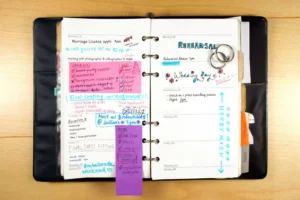All evening, I had troubles connecting with Tiffany. Now I’d reached my breaking point. What is with her? I wondered. What does she want from me?
The restaurant we’d come to dine in was filled with the usual buzz of conversation, clinking silverware and mouthwatering aromas. But the two of us sat at opposite ends of a table, Tiffany toying with her chicken salad and me munching my barbecue ribs. I replayed the evening in my mind.
I picked her up at her house and whisked her off to what I was sure would be a great evening at our favorite dinner spot. In the car I told her all about my day and she — well, she didn’t say a word. Then, when I opened the door to the restaurant, and commented about how I love coming here with her. That’s when she lobbed a stinging comment: “Are you sure you really mean that — or are you just being nice?”
I took a sip of water, and cleared my throat. Got to diffuse this bomb. “Uh, look, Hon — out the window. Isn’t that the most beautiful blue sky you’ve ever seen?!”
“It’s OK. But clouds are rolling in. It’ll rain soon. It always does.”
OK, new approach. “Uh, are you having a bad day or something?”
Tiffany just glared at me.
I leaned back in my chair. “Please tell me what’s wrong? Why are you acting this way?”
That’s when she let me have it. “I don’t even know why I came on this date. And you’re just sitting there acting like everything is normal.” She paused for a response but was met with nothing but a confused look. “A few days ago, you called me. ‘Hello, Tiff,’ you said, ‘how’d you like to go out with me?'”
“‘Sure,’ I responded.”
“‘Great,’ you said. ‘I’ll think up someplace fun to go, then call you with the details.'”
“I said ‘yes’ because I like spending time with you. But you can be so inconsiderate sometimes. I didn’t even hear from you until two hours ago. Then you said you’d pick me up around seven, and didn’t show up until almost eight. And so, I just sat there, wondering if would even come at all, feeling very foolish. Then my mind began to play games with me: What if he got in an accident? Is he OK? Did he get busy and forget? Does he think the world revolves around him … and that I’m supposed to just wait here? How can such a nice guy be such an insensitive jerk!”
Tiffany moved forward and locked eyes with me. “If you really care, then show some respect. Communicate. What’s going on with you?”
I slumped back in my seat, completely stunned — and thoroughly unsure about what to say next.
* * *
Tiffany and I eventually worked through that tense evening, not to mention countless other conflicts. Today, we’ve celebrated more than 10 years of marriage, and we’re the happy parents of the coolest 6-year-old boy on the face of the planet.
During the time we dated each other we learned a simple, yet profoundly transformational, connection key that helped clear up some of the “static” between us: Healthy relationships are fueled by healthy communication.
And healthy communication takes work.
It Begins With a Listening Heart
The fact is, each one of us is uniquely made by our Creator. We have our own pasts, dreams, experiences, hopes and hang-ups. So, it’s easy to get caught up in all of our individualism and forget that others may not have any idea what we are thinking. Even those closest to us can be left shaking their heads in confusion and sometimes frustration. Feelings get hurt, things get said, walls go up and communication comes to a screeching halt. These are the moments that shape a relationship. Do you hold your ground to the bitter end? Do you just give in and smooth things over to avoid an argument? Or do you strive to find some middle ground? Step back, take a break and try to see things from the other person’s point of view.
Men and women alike often feel misunderstood. In my opening story, I certainly gave Tiffany a good reason to be upset. By not discussing the issue before the date, her actions led to an awkward situation that played out in public.
With a little extra effort, the evening could have been much better for the both of us. An honest, heart-to-heart conversation — including a simple exercise in “Shared Meaning” (see “Six Connection Keys” below) — would have left both of us feeling heard and respected. Had Tiffany and I made an effort to iron out our differences first, we would have enjoyed a heartburn-free evening, not to mention a healthier relationship.
It Continues With a Listening Ear
Listening, according to Scott Peck in The Road Less Traveled, is the primary element in loving another person, and it is also the hardest work in a loving relationship.D. Wayne Matthews, Listening, (North Carolina: Cooperative Extension Service, 1993), 1. When we strive to hear what another person has to say, we communicate that that person is important to us.
All communication requires two basic things: a speaking voice and a listening ear. This sounds pretty simple, but it’s not. Most of us are very selective listeners, tuning in and tuning out as our interest dictates. With all the extraneous noise and worthless static that bombards us daily, this skill can be a blessing. It is something else, however, when we find ourselves tuning out those we say we love.Dr. Leo Buscaglia, Dr. Leo, Born for Love, (New York: Random House, 1992), 102.
Yet this is exactly how both Tiffany and I felt: tuned out emotionally. And it hurt deeply because we both desperately wanted to connect with each other.
Through the months, we had invested our hearts into this relationship — grounding it in friendship, faith and purity. It was now important that we work through some communication glitches. Our future together depended upon it.
The Nuts and Bolts of Communication
We were on the right track, communication barriers were coming down and were learning so much about each other. But since Tiffany and I were engaged to be married, we decided to get some professional help. We signed up for some premarital counseling sessions from a trained marriage and family therapist. We didn’t realize it at the time, but what we were about to learn would positively impact just about all of our interpersonal relationships — for the rest of our lives!
First, our counselor helped us to see that most men and women argue differently. Unfortunately, women can experience a lot of disrespect in this world. It pushes a big red hot button when it comes from those who are supposed to love and protect them. They can take on the world with vigor, but it cuts deep when they don’t feel emotionally safe in their personal relationships.
For many guys, a conversation is often a way to define a problem, debate the rights and wrongs, and find a solution. We discovered that, for me, verbal conflict was not entirely dependant upon feelings or being heard. It was often merely analytical. I would identify a problem, explore the options and then strive to “fix it.” Tiffany, like many women, usually finds the argument to be therapy. The act of talking and exploring is what they need. Not just to fix it and move on. We quickly learned that understanding communication styles and differences will enable both male and females to connect better with others in your life.
Second, we learned the value of an encouraging word. Mark Twain once said he could go for two months on a good compliment. Likewise, every one of us needs to be appreciated and adored for the awesome and unique person God made in us. We all need to be recognized for our strengths and to hear honest compliments. They are simple and cost nothing to give, but we must not underestimate their worth.
Six Keys to Connecting
Next, our counselor took us through some communication keys that, to this day, enable us to turn soured conversations into meaningful connecting points. Take a look at what we learned and try them out on your friends and loved ones.
KEY 1: Attitude is EVERYTHING. When your partner pushes your buttons, never fire back with an angry remark. (This only raises defenses and widens the gap.) A controlled temper and respectful tone allow for a better chance at conflict resolution.
KEY 2: Stay away from BLANKET statements. Phrases such as, “You never,” “You always,” “You don’t ever,” sound accusatory and cause the listener to become defensive. Instead, stress your particular wants and feelings by using “I.” For example, saying, “I want ” or “I feel ” are effective places to begin.
KEY 3: Maintain eye CONTACT. This can be difficult, especially when you’re upset. But looking away or ignoring your partner when he’s trying to talk to you is perceived by him as disrespectful.
KEY 4: Don’t pile on a bunch of CRITICISMS. Stick to the original topic of discussion. Pulling up unrelated and unresolved hurt feelings from the past, and introducing them into a new conflict, only confuses matters. This is a tactic often used to avoid the real issues.
KEY 5: Use a communication style called “SHARED MEANING.” Here’s how it works:
- Tiffany is upset because I didn’t call her back and showed up late for our night out. So she approaches me before we leave her house and says, “I just can’t go out with you until we sit down and talk.”
- Once I agree, Tiffany explains her point of view (which she has thought through ahead of time) without being interrupted.
- Next, I repeat what I heard her say.
- Tiffany then clarifies or confirms what she said, ensuring that her thoughts and feelings have been heard accurately.
- The process continues with me sharing my point of view, and Tiffany listening and repeating what I said.
The goal of Shared Meaning is to be heard accurately. And once each person has had a chance to state his case and listen to his partner, the foundation is set for communication — and for a fair solution to what’s upsetting each person.
KEY 6: When you’re wrong, own up to it and ask for forgiveness. That’s exactly what I had to do with Tiffany. She had a right to be upset, and I needed to make peace with her. In other words, finding a solution to our conflict wasn’t just about the two of us achieving more accurate and gracious communication. For me it was a realization that she was, in fact, entirely right — and I was in the wrong. As a consequence, I needed to give her a thoughtful acknowledgement of this truth, as well as an apology.
Bottom line: I’ve learned that I have to examine more than the facts in a given situation. What’s more, my focus should go beyond achieving good communication skills. I must examine my heart and motivations, as well. As I relate to Tiffany, I strive to recognize that not only is she a sinner, but the truth is that I’m a sinner too. And when I see a problem in my life that is a sin issue, I must immediately turn to our Lord and Savior. A Savior who is more than able to bring about healing and reconciliation.
Copyright 2008 Michael Ross. All rights reserved.









